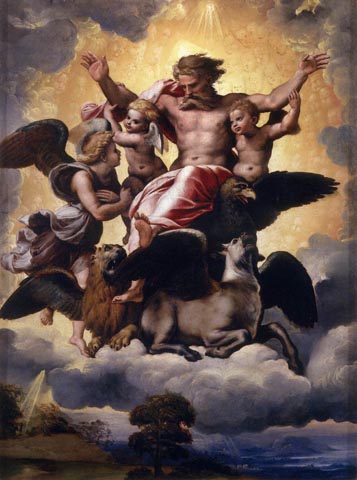Online Edition:
October 2012
Vol. XVIII, No. 7
The Vision of Ezekiel

The Vision of Ezekiel – Raphael (Raffaello Sanzio da Urbino – 1483-1520) 1518. Oil on wood. Galleria Palatina (Palazzo Pitti), Florence.
by Helen Hull Hitchcock
The Old Testament prophet Ezekiel begins his book by describing his vision of God, who always addresses the prophet as “son of man,” enthroned in the heavens among angelic hosts, supported by four winged creatures, having the faces of a man, a lion, a calf (or ox), and an eagle (Ezekiel 1:5,10). The same four creatures appear in the last book of the New Testament, Revelation 4:7-8: “And the four living creatures never cease to sing: ‘Holy, holy, holy, is the Lord God Almighty who was and is, and is to come.’”
Beginning with Saint Irenaeus (ca. 125 – ca. 202) and also in the writings of Saint Jerome (ca. 347-420) and Saint Augustine (354-430), the four creatures of Ezekiel’s vision were understood to symbolize the four evangelists, Matthew, Mark, Luke, and John. Though there was some variation among these early Church fathers as to which creature represented which Gospel writer, all agreed on the symbolic significance of the visions of both Ezekiel and Saint John the Evangelist in expressing the unity of the Old and New Testaments.
It is the interpretation of Saint Jerome that has prevailed to this day. In the preface to his Commentary on the Book of Matthew, he wrote, “The first, the face of a man, signifies Matthew, as it was about man that he begins to write: ‘The book of the generation of Jesus Christ, son of David, the son of Abraham’ [Matthew 1:1]; while the second is the voice of Mark in which is heard the roaring of a lion… ‘A voice of one crying in the wilderness: Prepare ye the way of the Lord, make straight her paths’ [Mark 1:3], and the third by the evangelist Luke, for Zachariah the priest took the calf, foretelling the sacrifice [cf. Luke 1:5]; and the fourth is John the evangelist, who preaches concerning the word of God by assuming the wings of an eagle and hastening to the heights [cf. John 1:1-13].”
In Raphael’s depiction, the tiny figure of Ezekiel can be seen at the lower left, as rays of light from the clouds shine on him. God, with His arms supported by cherubim, is seated on the wings of the eagle (John), surrounded by the winged man (Matthew), lion (Mark), and ox (Luke).
***
“The New Testament is hidden in the Old and the Old is made manifest in the New,” as Saint Augustine perceptively noted. It is important, therefore, that in both pastoral and academic settings the close relationship between the two Testaments be clearly brought out, in keeping with the dictum of Saint Gregory the Great that “what the Old Testament promised, the New Testament made visible; what the former announces in a hidden way, the latter openly proclaims as present. Therefore the Old Testament is a prophecy of the New Testament; and the best commentary on the Old Testament is the New Testament.”
— Pope Benedict XVI
Verbum Domini §41
Apostolic Exhortation following
Synod on the Word of God, Sept. 30, 2010
***
*



